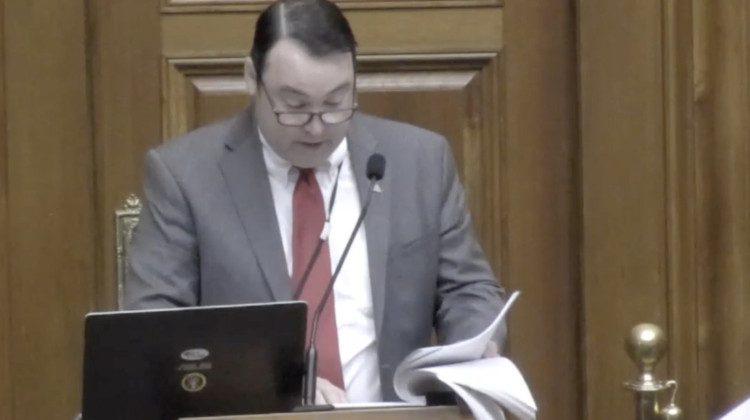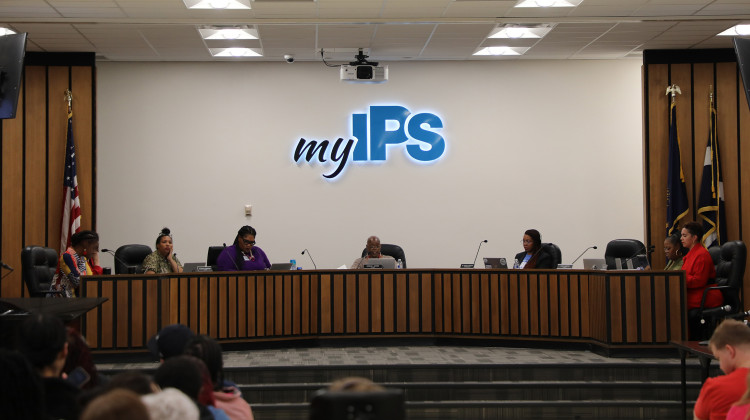
The ILEARN results released Wednesday by the Indiana Department of Education confirm what many local educators feared: students fell behind academically after switching to online learning and faced other disruptions during the COVID-19 pandemic.
(Eric Weddle/WFYI)Some Marion County schools earned the lowest passing rates on the state’s latest standardized test. And long-standing achievement gaps for low-income students and Black students at some Indianapolis school districts remained far below their peers and the statewide average.
The ILEARN results released Wednesday by the Indiana Department of Education confirm what many local educators feared: students fell behind academically after switching to online learning and faced other disruptions during the COVID-19 pandemic.
State Secretary of Education Katie Jenner said it will take years for students to recover. She urged schools, families and communities to work together to find ways to improve academic achievement.
“These are not problems anyone can fix overnight,” Jenner said. “This is going to take an extended effort to get us back to where we were.”
Indiana Releases 2021 ILEARN Data, Highlights Academic Impact Of COVID-19
ILEARN, or Indiana's Learning Evaluation and Readiness Network assessment, measures the following subjects in each grade level: English Language Arts and mathematics in grades 3-8, science in grades 4 and 6, social studies in grade 5, and U.S. Government and biology in high school.
This is the second time students have taken the ILEARN test since the state issued its final ISTEP assessment during the 2017-2018 school year. Students did not take standardized tests during the 2019-2020 school year due to school closures and a federally-granted testing waiver that was issued in response to the COVID-19 pandemic.
And the abrupt shift in instruction caused by the switch to remote learning is one of the reasons why results are so low, state officials said.
Marion County Test Scores Mostly Lower Than State
Statewide, 40.5 percent of students are at or above proficiency standards in English Language Arts and 36.9 percent are at or above proficiency in mathematics.
But in Marion County only three of 11 school districts surpassed the statewide average of 28.6 percent for students who passed both math and English tests: School Town of Speedway at 42 percent, Franklin Township Schools at 33 percent and Perry Township Schools at 29 percent.
Warren Township Schools had the lowest pass rate — 8 percent — for districts in Marion County.
Some schools in the county reported a zero, or one percent or less rate for students who passed both the math and English tests. This includes non-traditional, charter and neighborhood schools such as: Indianapolis Public Schools’ James Russell Lowell School 51, Ralph Waldo Emerson School 58, and Arlington Community and Northwest Community middle schools.
Urban Act Academy is a school restarted by IPS with an outside operator in 2018, due in part to low test scores, and serves multiple homeless shelters in the school’s boundary. None of those students passed both parts of the test.
According to a statement from IPS, the school district has already implemented changes at James Russell Lowell School 51 and Ralph Waldo Emerson School 58, where less than 1 percent of students passed.
“Some grade level and staffing changes have already been made at both schools for the upcoming year,” the district said. “Both are part of the district Transformation Zone and receive additional state funding we plan to leverage for these schools.”
More than 70 schools across the county reported a passage rate of less than 10 percent for both parts of the test.
The results are even bleaker when broken down by demographics. In Marion County, Black students performed as low as 2 to 4 percent in Beech Grove City Schools, IPS and Warren Township.
Statewide, some of the students with the lowest scores in both ELA and math were children who identify as Black (8.1 percent), Hispanic (15.6 percent), English language learners (6.7 percent), students who receive special education services (8.3 percent) and those who receive free or reduced meals (15 percent).
This is compared to students who are Asian (46.5 percent), white (34.7 percent), or students who receive paid meals (41.1 percent). That’s roughly three times, or more, than the lowest performing students.
The state anticipates further drops in academic performance in other subject areas. A study examining the impact of the pandemic on student achievement is expected later this summer.
Responses From Marion County School Districts
District leaders received their scores before the end of school year, a state spokesperson said. But some school districts were still hesitant to comment on the test scores as they continue to analyze the data.
IPS said it, like many school districts around the country, are using one-time federal funding in order to fund new improvements to combat learning loss.
“We have invested in learning and technology platforms that have specific programs for English language learners and students with special needs that help differentiate learning and scaffold interruption to meet students where they are and accelerate their skills,” IPS said.
IPS said it is also planning more tutoring services and will potentially offer extended learning opportunities, which will be announced this fall.
Perry Township said the district’s assessment known as Evaluate “is a more accurate reflection of our students’ proficiency,” according to an email response from the district. They plan to use results from that test to determine student instruction.
In a statement, Wayne Township Schools said students will receive increased support in the upcoming school year.
“We assert that students didn’t lose anything they learned. Instead, some students did not learn as much last year as they might have in a non-pandemic school year,” the statement from the district said.
Wayne Township leaders expect to use federal pandemic funding to increase support in mental health, outreach to families and offer more learning opportunities outside of the traditional school day.
“We will closely monitor student progress and work to accelerate learning and address gaps caused by the pandemic,” the district said.
Low Scores Aren’t A New Trend
Even if schools can bridge the achievement gaps caused by the pandemic, educators still have a long way to go before a majority of students are proficient. This isn’t the first year standardized test scores have been low. Statewide results of the 2019 ILEARN assessment showed that proficiency rates were roughly seven percent higher than this year -- 47.9 percent for English Language Arts and 47.8 percent for math. Only 37.1 percent of students passed both tests that year.
But the state said this year’s results shouldn’t be compared to the 2019 scores since this year’s results create a new baseline for comparing future testing data.
Since the state didn’t compare test data between the last year of ISTEP and the first year of ILEARN, that means Indiana has not had comparable standardized testing data for the past three years. ILEARN scores won't be used for school accountability, with lawmakers approving a "hold harmless" measure earlier this year and the U.S. Department of Education waiving federal accountability earlier this year.
Brandon Brown, CEO of local education reform group The Mind Trust, said he doesn’t think the lack of accountability from the state, school districts or educators is the issue.
“I don't think anybody is to blame,” Brown said. “I do think this oughta make us question the traditional K-12 education system, and really ask ourselves what went wrong over the past year and a half, and what lessons can we collectively learn moving forward, to make sure that we're continuing to innovate to build a system that is more nimble and is able to meet the needs of our families much more successfully.”
The Mind Trust, which partners with IPS, will continue to work with schools to figure out ways to best serve students. Brown said replicating strategies at schools that serve Black and Latino students well, could be a way to redesign the school system as the IPS district aims to drastically increase student performance to 50 percent by 2025.
As school districts prepare for the upcoming school year and figure out how to spend millions of dollars in federal funds, the state is encouraging districts to implement a multi-year learning recovery strategy.
Contact WFYI education reporter Elizabeth Gabriel at egabriel@wfyi.org. Follow on Twitter: @_elizabethgabs.
 DONATE
DONATE





 View More Articles
View More Articles



 Support WFYI. We can't do it without you.
Support WFYI. We can't do it without you.